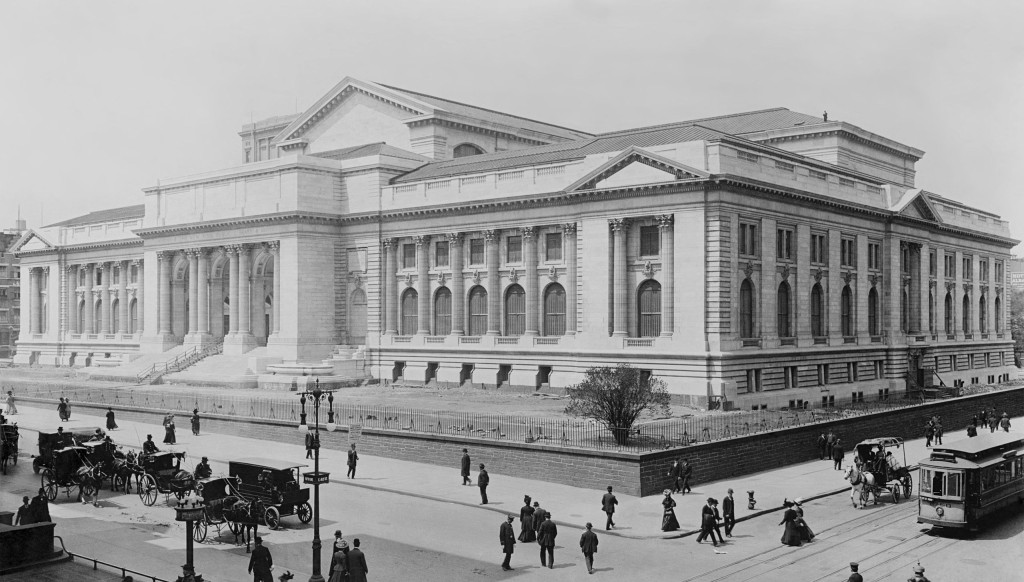Theorizing a Role for Public Media in American Society in the 21st Century

The New York Public Library, glass negative from 1908 depicting horse carriages and trolleys. Late stage construction.

Public media in the United States, as we know it today, exists almost as if it were a relic from another era of American life, namely the era of President Lyndon Johnson’s “Great Society.” This endeavor, embodied in an extensive series of domestic welfare programs, brought forth the National Endowment of the Arts (NEA), the National Endowment for the Humanities (NEH) and what became the Corporation for Public Broadcasting (CPB), best known for financing the Public Broadcasting System (PBS). They were part of Johnson’s vision for America, a vision that included the concretization of civil rights for African Americans and an end to the tools of civic discrimination still widely practiced at polling stations of the period. The public broadcast was meant to educate the American public in the broadest sense of civic responsibility and to work for its general well-being by subsidizing art for public consumption and promoting literacy.
Today, however, the Great Society’s programs have been diminished by years of budget cuts and sea changes in American politics. We therefore must reformulate the question: what should be the role of state-subsidized arts and media? State-subsidized arts and media have, very successfully, educated American children and adults. PBS, for example, broadcasts news shows and documentaries ostensibly free of corporate and partisan political favor. It also broadcasts live music and dramas.
But public media faces genuine challenges in the 21st century. As opposed to Fox News or MSNBC, which have clear partisan agendas, PBS and NPR have relatively small market shares: meaning that they reach fewer households. Furthermore, public networks are indeed susceptible to political influence. In a 2004 Harper’s Magazine article, Eugenia Williamson bemoaned that no PBS affiliate would air the documentary Citizen Koch, which was critical of the campaign financing methods of the Koch Brothers (Charles and David), major Republican Party (and also CPB) financial contributors. This example illustrates how PBS is ultimately dependent on CPB and NEA donors, whose political preferences can, in fact, influence public broadcasting through the power of the purse.
It is evident that the education of the American public requires an evolution of public media. And the role of public media should not only be modernized, but it should in turn be part of a general modernization of American society that looks to create equal civic opportunity for its citizenry. In order to do so, we must reexamine the founding myths of the American republic, its civil society and its inequalities and failures. We must acknowledge the realities of the general cultural landscape and how these help or hinder individuals’ education. A relatively small proportion of Americans possess (and have historically possessed) disproportionate economic and cultural capital. Publicly-funded art and education programming still retains an ideal position to remedy these distortions in American society.
The “freedom” symbolized by the American Revolution has for centuries existed—discordantly— alongside racial and gender inequalities. While white male Anglo-Saxon citizens were empowered after the American Revolution, women, African Americans, and other minority groups were excluded for a long time (and in many respects, this remains the case today). Members of the lower socioeconomic classes, until the advent of public libraries, had comparatively limited access to learning and cultural capital to successfully navigate a society as the landed gentry or merchant class. And many of the same problems, challenges of civic opportunity and cultural accessibility, persist today in the United States, where at least 16 million children live under the poverty line, according to the National Center for Children in Poverty. Publicly-funded media and art should aim to enlighten every individual about American histories of race, of economic disparities, of the struggle for gender equality. They should also continue to uphold their mission to promote the study of science, humanities, and economics. Public TV and radio contribute to a citizen’s daily life with information that broadens their horizons, but also gives them cultural capital in order to navigate this society’s inequalities. This will become relevant in the way people vote, but also how they live in their cities, towns, counties, states, and the nation. Who of three hundred million people will be the person to try a healthy fast food innovation seen on the news? Who will want to learn of new small-scale manufacturing methods, made available on a website subsidized by the government, and create a small business to put a daughter through college? Which teacher will know the historical facts about the majestic bridges that are among this country’s greatest engineering achievements and teach them to their class? Finally, who will be able to understand a local economy enough to know exactly what range of policies are expected? Detroit, Michigan; Camden, New Jersey; Jackson, Mississippi: the challenges that these cities face will be better met in a developed, well-informed and educated nation.
Our age of public universities and of public libraries, an age of inexpensive books that cost one cent (plus $3.99 shipping) on Amazon.com, is also an age of massive inequalities, a new Gilded Age. The average American is still far from having the same access to education as the infamous “one percent.” The very nature of public arts and media is to make that gap smaller. It is critical that our society recognizes public media’s unique and invaluable role, and in turn, provides the much-needed resources and support to assure this role in future generations.
Adolf N. Alzuphar is a Haitian graduate of the George Washington University with a B.A. in Political Science. He would like to become a public historian and currently works for a Senegalese re-released music label called Teranga Beat.




